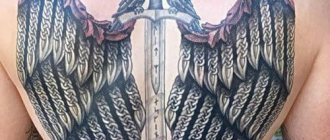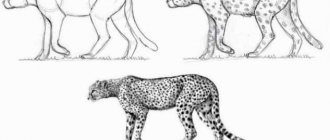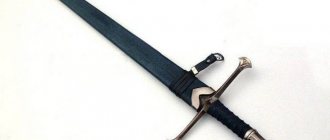Golden rod braided with snakes with wings and the tip in the form of a ball - a symbol that came from antiquity. It is a constant reality in the mythology and religion of the most diverse peoples of the world, be it the Romans, the Indians or the Egyptians. The mysterious rod is called the caduceus. What is it and why did the ancient gods need it? How was it used in the Middle Ages and how does man use it in today's reality? To these and many other questions we will answer by taking a short journey into the history of this ancient symbol.
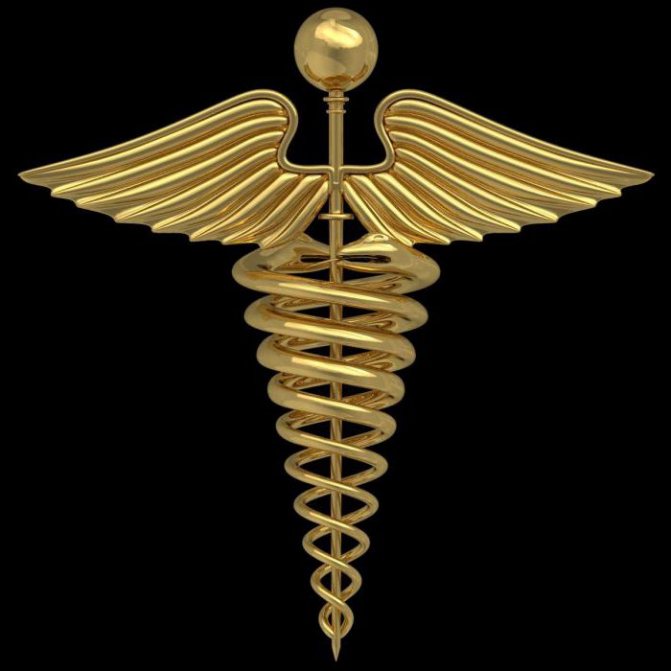
What did the caduceus symbolize in ancient Egypt?
And in ancient Egypt, as some researchers believe, there was a special kind of caduceus. The caduceus was a rod crowned by the sun and the moon.
It is quite possible that the caduceus, like the Ureus, symbolized the unity of Upper and Lower Egypt. At the same time his rod embodied the world axis supporting the daylight and its satellite. The snakes wrapped around it represented the lunar gods who were closer to earth, and the wings represented the heavenly gods who lived near the sun.
But after the great war that broke out between them, the situation changed somewhat. The lunar gods moved under the earth, while the celestial (solar) gods moved to its surface. In connection with this, the caduceus was interpreted differently. Its meaning was now reduced to the unity of the underworld and the terrestrial world, illuminated by moon and sunlight.
The caduceus was usually held by Anubis, a god with the head of a jackal and the body of a man. He once escorted the dead to the afterlife. Perhaps it was from him that the ancient Greeks borrowed this amazing symbol.
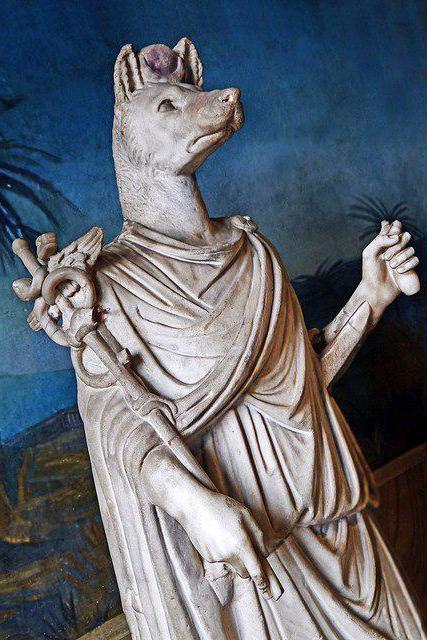

Ancient Interpretations
The meaning of such a symbol is interpreted differently. All due to the fact that such an image is used in various spheres.
One of the meanings characteristic of ancient Rome is the connection of mystery and virtue. As the snakes braid the staff so that circles of two halves are formed, one of the interpretations indicates the connection of opposite sides: darkness and light, evil and good, etc. This fusion is a peculiar symbol of nature.
The significance of the Caduceus symbol was once in the union of Lower and Upper Egypt. In those days, the inhabitants of Egypt deciphered it as the connection that exists between our world and the underworld. Such an image also represented the connection between the Sun and the Moon.
The serpent is called the personification of the forces of separation, connection, descent and ascent, fertility, wisdom, the ability to renew.
The wings are also part of the Caduceus for a reason. It is a sign that the wisdom that carries snakes or other opposing elements, personified by them, came from heaven. The wings symbolize the ability to cross all boundaries.
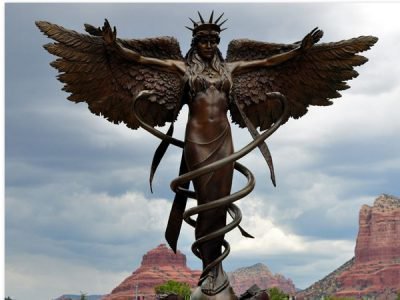

The staff, on the other hand, symbolizes three main meanings.
- Power.
- The axis that connects the Earth and Heaven.
- The tree of life.
Plexus of vipers deciphered as a crossing of the right and left stream of psychic energy. Then it turns out that the image indicates the restoration and maintenance of balance between the currents of life in the corporeal shell of people and life.
Since there are 7 points in the sign where the snakes touch, such a symbol is often associated with the seven chakras located in the human body.
Caduceus in Ancient Greece and Ancient Rome
In ancient mythology, the caduceus was called "the rod of Hermes" and had the ability to reconcile enemies. The ancient Greek god of trade, dexterity and eloquence, according to one version, received it from Apollo, the patron of arts, in exchange for a whistle; according to another, from the skilled smith Hephaestus. And the Roman prototype of Hermes, Mercury, got the rod from Hades, the god of the underworld.
Initially it looked like an olive branch with two sprouts wrapped in garlands. Later they were transformed into serpents, and the rod acquired wings. Ancient legends say that Hermes (Mercury) once saw snakes fighting under the spreading branches of an oak tree. To reconcile them, the god threw a caduceus between them. The miracle was accomplished, and the snakes immediately stopped fighting. But two of them in a fit of rage circled around the caduceus of Hermes and froze for ever, meeting their gaze with each other.
Later the ancient Greek god gave the rod to his son Neric. It was from him that the line of heralds descended. As a sign of their immunity, they took the caduceus with them when they went to distant lands. At the same time, the rod of Hermes became a symbol of trade, wealth, prosperity, and mutual understanding and reconciliation. But it was not all the incarnations of the caduceus. A photo of the image of the ancient Greek deity with the famous rod in his hand is shown below.
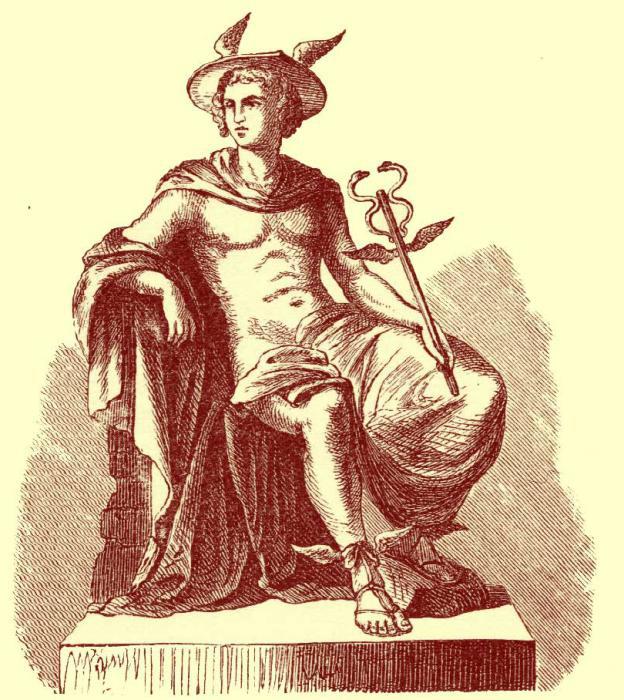

Dionysus's Thyrus and Caduceus
The caduceus bears some resemblance to the thyrse of Dionysus, the ancient Greek god of wine, inspiration and religious ecstasy. His rod was made of a fennel stem and crowned with a pinecone. The tirs of Dionysus was wrapped in ivy, which sometimes turned into a snake. This transformation was mentioned by Plutarch. Maybe that's why some researchers consider the thyrus a kind of caduceus.
In ancient Greek myths, the rod of fennel was an obligatory attribute of the mysteries of Dionysus and a sign of the great creative beginning. In the myths of the Greek myths, the rod of fennel was a must-have attribute of the Dionysian mysteries and a sign of the great creative power of the god.
The meaning of tattoos for men
Excellent health and a positive attitude distinguish men who have decorated their bodies with a caduceus tattoo. As a mascot, the sign is chosen for the tattoo by athletes, active travel lovers, because the wings denote diligence, and the snakes - health and flexibility. The active balance inherent in the image of the divine rod, helps the wearer to always maintain good physical shape, avoid dangerous injuries.
Fans of Oriental philosophy put the ancient sign on the body, trying to get the ability to perfectly control the state of mind and body, achieving complete harmony in thought and deed. The tattoo helps businessmen in their professional activities, providing the ability to negotiate and find compromises, and for medics and rescuers becomes a talisman, a source of spiritual energy and a sign of hope.
For lovers of nature and the natural world, the caduceus tattoo represents the unified force of all four elements: the rod is earth, the wings signify air, and the two snakes act as an image of fire and water. Often, the tattoo is a sign of peace, which helps to rid the world of the "poison of war. The owners of such personal drawings, made in the same color scheme, are distinguished by their judicious and calm temperament, have a talent for resolving any conflicts with the help of kind and peaceful words.
Caduceus and the awakening of the kundalini
In India, an ancient symbol has also been discovered, the shape of which resembles the caduceus. What it is, you can really feel only by immersing yourself in the religion of this country. In Buddhism, this symbol is closely related to yoga and meditation and has a special meaning. The snake is identified with the energy concentrated at the base of the human spine. There it lies, coiled spiral in three and a half turns. Otherwise, Buddhists call it kundalini.
The caduceus rod is like the sushumna, a hollow channel in the spine. Upon awakening, the energy divides into streams. Like serpents, they wind around the sushumna, passing through the channels idu and pingala, forming an intersecting spiral and connect at seven points. The pattern of energy flows visually resembles a caduceus symbol.
Kundalini awakening is achieved by Buddhists through specific exercises and a particular mindset. It is characterized by "inner fire," clairvoyance, telepathy, heightened intuition, changes in sexual temperament, mood swings, and visions.
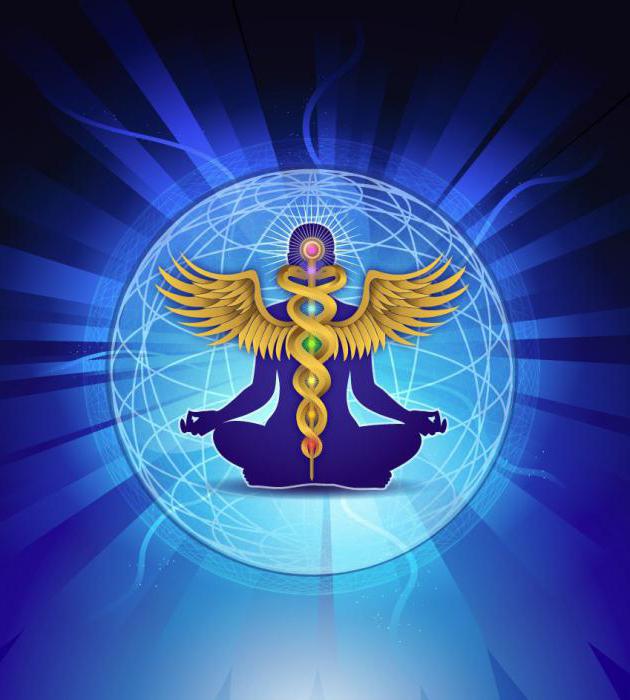

What did the caduceus mean in alchemy and medicine?
During the Renaissance, the medicinal properties that the caduceus had thousands of years ago in Mesopotamia became relevant again. The medical symbol created by its inhabitants was now used by alchemists. As a rule, they put the seal with the image of Hermes and the caduceus on the vessels with medicines. The rod of the ancient Greek deity who became the patron of alchemy was often crowned with a raven.
The wings of the caduceus symbolized the ability to cross any boundary, the serpent symbolized the unity of opposites: illness and healing, and the rod was the axis of the world. The alchemists strove to find the perfect cure and chose this emblem for a reason. According to occult sciences, it was the caduceus that could reveal the mystery of life and death. Medicine, however, soon received a different emblem - a bowl with a snake.
It is also considered a symbol of the staff of Asclepius. It is sometimes associated with the caduceus. The staff of Asclepius is a wooden rod wrapped in a snake. Its history is also rooted in ancient Greek mythology, but it has nothing to do with the caduceus.
Aaron's rod
Also of some interest is the rod of Aaron, which belonged to the ancestors of the Jewish high priests, and which was of the same shape as the caduceus. What is it and what is its history?
According to European occult science, Aaron's rod contained sacred fire. It is believed that he could turn into a serpent and devour his kindred. With his help, Aaron, brother of Moses, was able to carry out three Egyptian executions: punishment by blood, execution by toads, and invasion by gnats.
Another amazing story is associated with the rod, which occurred during the wanderings of the Jews in the desert. As they wandered through the high dunes, the people of the different tribes got into a bitter dispute. The reason was the election of the Levites to serve God. The representatives of the other tribes, however, also had their own claim to this privilege. In order to settle the dispute, they resorted to God's judgment and laid their rods in the Tabernacle overnight. In the morning, the Almighty gave the decisive sign: Aaron's rod was covered with leaves, flowers and almonds. This miracle was the final proof of the chosen of God by the Levites.
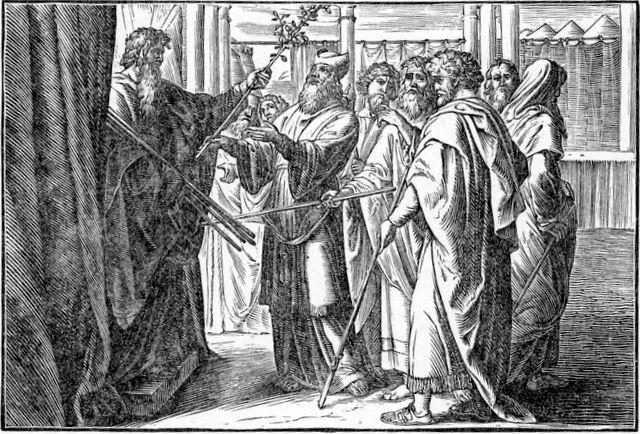

The Ancient Symbol in Christianity
In Christianity, the caduceus became an attribute of Our Lady Sophia. Her image with it can be seen in Orthodox iconography. Sitting on a golden throne, Sophia holds in her right hand the caduceus. Only it is crowned not with a rounded tip, but with a tip.
We can suppose that it is a symbol of power, but more likely the rod carries a certain spiritual meaning. It resembles the copy with which in Orthodoxy it is customary to cut bits from the prosphora as a symbol of the penetration of the body of the Lamb. And this action is a reference to an ancient event when the Roman soldier Longinus pierced the side of the crucified Christ with his spear on Golgotha.
What is the symbol of the caduceus?


The caduceus staff was often "placed" in the hands of the gods Serapis, Asclepius, Hermes, Mercury, or Aesculapius. In all cases, however, it was a symbol of universal movement, as well as of eloquence and prudence. It is also believed that the staff itself is the axis of the world along which the mediating gods move. It is on this basis that the caduceus was often seen in the hands of messengers of peace and protection as their main attribute.
What else could the caduceus mean?
There are many other speculations as to what the caduceus could mean. In psychoanalysis it is a phallic symbol, and in hermetic semiotics it is the key to the afterlife. It is believed that Hermes opened the door to the underworld with the caduceus.
The rod traditionally means power over the forces of nature, and the snakes symbolize the opposing sides, striving for unity: light and darkness, fire and water, male and female. Their symmetrical arrangement suggests a harmonious development of the spiritual and material.
The central part is commonly identified with the world axis, along which the intermediary gods move between heaven and earth. From the point of view of some researchers, Hermes was such, that is why he got the caduceus. What is it, we have disassembled, but how is it used now?
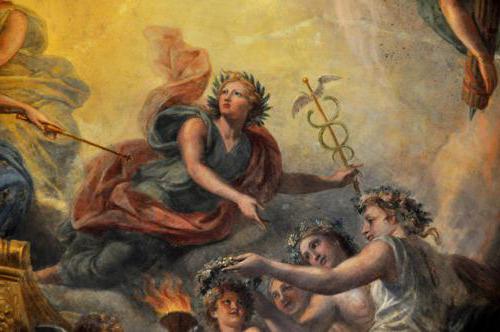

LiveInternetLiveInternet
The caduceus.
This symbol is so ancient that it is impossible to establish the time of its appearance. It is known that it was borrowed by the Greeks from the Egyptians, who used it before the time of Osiris. Later, the caduceus passed from the Greeks to the Romans.
The Staff of the Caduceus
The caduceus is a golden rod with serpents symmetrically arranged around it. Sometimes it is crowned by a pair of outstretched wings. The word caduceum came into Latin from Greek, where it was used to mean "messenger", "harbinger".
It was associated with various deities:
- Ancient Egypt.
- Rome
- India
- Greece
- Phoenicia
- Sumer
- Whole Mediterranean
- Iran
- The Americas before Columbus discovered the continent
Which deities wore the rod of power
Signifying health and youth, the caduceus is considered an attribute of the Greek god Mercury (or by analogy, the Roman god Hermes). It is worn by many other deities, among which we can recall the Egyptian Anubis, the Phoenician Baal, and the Sumerian Ishtar. In Christianity, the caduceus can be seen in the right hand of St. Sophia depicted on numerous icons.
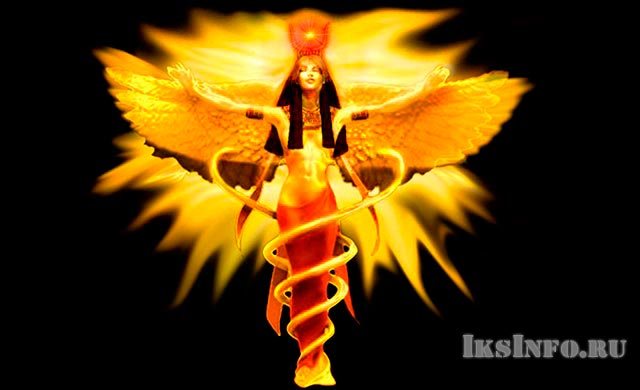

Whatever deity had it: Hermes, Serapis, Aesculapius or Asclepius, the caduceus always served as a representation of the principle of universal motion. The attribute symbolizes the natural forces interacting and complementing one another.
The Caduceus of Hermes
There is a theory that the symbol originally resembled the outline of a branch from an olive tree or a rod decorated with several leaves. Later, the original image changed, getting the tip in the form of a ball and a crescent, and later two snakes were added entwining the central rod. If other sources are to be believed, the image of the snake has always been an integral part of the caduceus and was used as a sign of healing.
Homer believes that Hermes obtained the caduceus after an exchange with Apollo - by giving for it a whistle. There is a cardinally different theory, according to which this attribute was made for Hermes. According to the legend, Hermes used the staff to separate two snakes fighting each other. As a result, the latter became attached to the central rod.


The caduceus could be used to put people to sleep and wake them up. That is why it is often depicted as an emblem of dreams. In the context of psychoanalysis, the caduceus is a phallic sign. It is associated with the sublimation (mechanism of getting rid of internal tension) of sleep.
In a broader interpretation, the caduceus appears as a symbol of magic and sorcery. According to Hermeticists, who study the higher laws of nature, the caduceus is the key to the underworld. They believe that Hermes uses it to open the gates of the afterlife to the souls of the dead.
In Roman mythology, however, the double of Hermes, Mercury, is said to have used this staff to reconcile two fighting serpents (disorder, chaos). Since then, in ancient Rome, the Caduceus has been considered a symbol of peace, harmony, equilibrium, and virtuous behavior.
Epictetus says:


A variation of the Caduceus.
Some scholars believe that the Caduceus had some sort of prototype in ancient Egypt. It was a rod rimmed by the moon and the disk of the sun. There was an opinion that it was the same rod in which reverence for the Sun was combined with a belief in the mystical powers of the Moon. The caduceus can be made in the form of a ball and topped with horns, which symbolizes the Sun in Phoenician and Hittite culture. Discovered in India, the Caduceus is considered an astronomical sign of Hermes (or Mercury).
The meaning of the Caduceus in different cultures
The existing interpretations of the significance of the caduceus in the modern world are astounding in their number. In practically all cultures, this symbol is mainly isolated by proportionality. This means that the evolution of matter cannot proceed at a faster or slower pace than the evolution of spirit.
The wings on the rod encapsulate the ability to overcome any obstacle. They are associated with the element of air and the embodiment of spirit.
The rod with two snakes winding around it combines several basic symbolic elements. The central rod contains the phallic power and symbol of the Tree of Life, signifying the connection between heaven and earth. The rod itself represents the axis of our world, along which various mediators and messenger gods move from bottom to top and vice versa. That is why the caduceus, symbolizing peace and protection, is considered the main symbol of all messengers.
Snakes turned up heads form a double helix, indicating the cosmic energy. They also represent the unity of the opposites, which seek to connect. Separately, the serpent is the fruitfulness of the forces of earthly and afterlife.


The caduceus combines two cardinally different forces of the universe that have a complementary nature.
These include:
- Good and Evil.
- Fire and water
- Connection and separation
- Ascent and Descent.
The caduceus also symbolizes the union of the two sexes. It is the embodiment of equilibrium and a conventional designation of one of the models of the World.
In Asia Minor, a pair of snakes was often used as a symbol of fertility. In Mesopotamia, two twisted snakes embodied the god-healer. They mean evolutionary changes and paired beginning of the universe, as yin and yang in the concepts of ancient Chinese natural philosophy. Symmetrical placement of snakes and wings reveals the balance of opponents, emphasizes the harmony of development of the lower and higher (bodily and spiritual) levels.
Still snakes mean a periodic renewal of Nature and the world Order in case of its violation. They are often seen as a symbol of wisdom.
Caduceus in alchemy
In alchemy, these serpents are associated with the unity of opposites (mercury as female and sulfur as male). They are identified with the infinite possibilities of transformation, sleep and awakening, the mutual complementation of opposites and meditation, linking the highest and lowest levels of reality.
In medicine, one of the snakes is considered healing and the other is considered poisonous. They symbolize health and disease. The main message of the symbol in hermeticism and homeopathy: nature is able to overcome nature.
Caduceus became associated with alchemy as a "hermetic science" as early as the Middle Ages. Then it was gradually transferred to the general designation of esotericism and the occult sciences. It was originally considered the main symbol of medicine, but over time it was superseded by a bowl with a snake. The two snakes could allude to the ambiguous nature of medicine: the snake's sting could be used for therapeutic purposes as well as for poison.
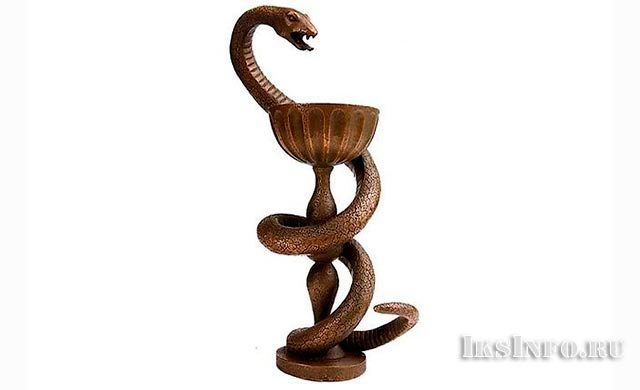

The caduceus began to be identified with medicine due to the presence of snakes in it, which symbolized rejuvenation. The Roman god of medicine, Aesculap, had an attribute in the form of a rod with one snake. According to Jung's theory, the caduceus symbolizes homeopathic medicine, where snakes can denote both poison and medicine.
The meaning of the Caduceus in Buddhism
An attribute resembling the caduceus was found in monuments from ancient Indian times. For the past 4,000 years it has been associated with the powers of the gods. In India, Phoenicia, Babylon and Egypt it served to designate the energy of awakening - kundalini, or Serpent Fire.
In esotericism, the caduceus rod is analogous to the axis of the world. In the context of this science, serpents refer to the cosmic energy (called kundalini). This energy is represented as a unique force coiled at the base of the spine. Curling around its axis, the snakes find seven points of contact. These points are associated with the chakras.
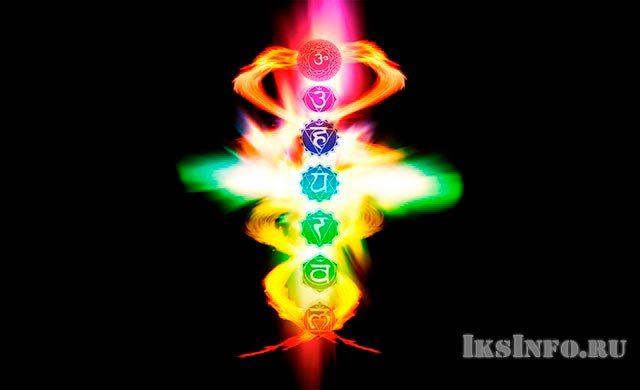

The energy called kundalini is believed to be dormant in the base chakra. And if the evolutionary process awakens it, it rises up through three channels: the central path and two side paths, which form two intersecting spirals - the male and the female. The male spiral is active and located on the right, the female spiral is passive and located on the left.
Whichever interpretation of the caduceus is correct, most scholars and researchers believe that this symbol belongs to one of the most ancient designations of the Creating Force. This is why it was believed that the owner of the caduceus had access to all the laws of knowledge governing Nature.
The Caduceus nowadays
Today the caduceus is used as a symbol of commerce and diplomacy. It stands for the secrecy of political or commercial correspondence. The caduceus is part of the symbol of the Federal Tax Service of the Russian Federation. In the not so distant past, it was often used in heraldry. For example, the coat of arms of Kharkov Province was decorated with this symbol. It appeared on the coats of arms of a number of cities in the Russian Empire, including Nezhin, Irbit, Berdichev, Balta, Feodosia, Talny, Yeniseisk and Tiflis.
In the United States the caduceus was used as a symbol of medicine.
Retrieved from https://www.iksinfo.ru/stati/artefakti/item/944-kadutsey.html
Caduceus in modern heraldry
In the modern world the caduceus is used in the symbolism of the chambers of commerce and industry in many countries around the world. It is included in the emblems of arbitration courts and the Federal Customs Service of Russia, as well as the U.S. Army Medical Service. The caduceus is also depicted on the emblem of the Finnish city of Jyväskylä.
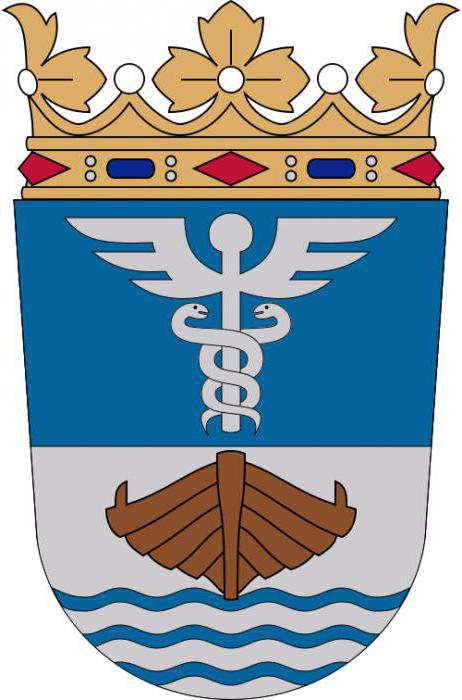

As you can see, the ancient symbol is still considered popular and relevant. It was once held by Egyptian, Roman and Greek gods. With it they performed deeds, awe-inspiring people, and now the caduceus is a symbol depicted on the emblems of federal agencies and government departments. However, it still preserved the mysterious spirit of ancient times.
The meaning of the tattoo for girls
Caduceus tattoo characterizes the owner as a sensible and sociable girl. This ancient sign of the messenger or herald, depicted in bright colors, symbolizes the ability to make peace and end any quarrels. Tattoo owners masterfully tame heated arguers, find powerful arguments to calm angry people and always encourage the frustrated.
Replacing the wings of the caduceus with painted airy butterfly wings in the tattoo plot speaks of the owner's love for beautiful clothes, bright accessories, jewelry and cosmetics. The symbol of harmony and perfection, applied to the body, helps a girl to develop impeccable taste and always look worthy, even if nature has not awarded her an outstanding beauty.
